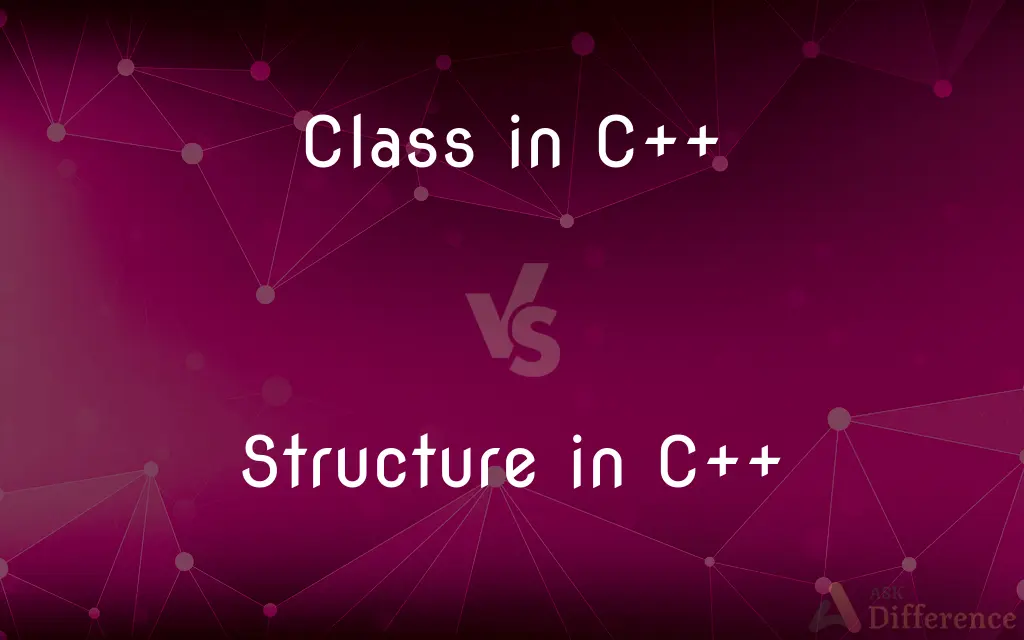Class in C++ vs. Structure in C++ — What's the Difference?
By Tayyaba Rehman & Fiza Rafique — Published on February 4, 2024
In C++, a class supports both data encapsulation and methods, with default private access. A structure, while similar, defaults to public access and typically represents data only.

Difference Between Class in C++ and Structure in C++
Table of Contents
ADVERTISEMENT
Key Differences
A class in C++ is a blueprint for creating objects, encapsulating data and functions. It supports inheritance and polymorphism, integral for object-oriented programming. In contrast, a structure in C++ is traditionally used to group different types of data. Structures are often used for simpler data representation without the need for additional functionalities like methods.
In a class, member variables and functions are private by default, meaning they can only be accessed by the class's own methods. This promotes data hiding and encapsulation, a cornerstone of object-oriented design. Meanwhile, a structure in C++ has members that are public by default, allowing direct access from outside the structure, which can be less secure but simpler for straightforward data storage.
Classes in C++, with their support for private and protected members, are well-suited for complex applications where control over data access is crucial. They enable the creation of robust and secure software systems. Structures, being more open, are better for when data needs to be accessed directly without the overhead of function calls, useful in scenarios like interfacing with hardware or simpler data manipulation.
A notable feature of classes is the ability to define constructors and destructors, methods called at the creation and destruction of an object. This feature allows for initializing class members and cleaning up resources. Structures can also have constructors and destructors in C++, but they are more commonly used without them, making structures simpler but less flexible compared to classes.
In conclusion, while classes and structures in C++ share many similarities, especially since C++11, they are designed for different purposes. Classes offer more features and control, ideal for complex applications, whereas structures are simpler and more transparent, suitable for basic data aggregation.
ADVERTISEMENT
Comparison Chart
Default Access Modifier
Private
Public
Primary Use
Complex data types with methods
Simple data aggregation
Supports Inheritance
Yes
No
Encapsulation
Encourages data hiding
Allows direct data access
Constructors/Destructors
Commonly used
Less commonly used
Compare with Definitions
Class in C++
In C++, a class can inherit properties from another class, enabling polymorphism.
Class ElectricCar : public Car { private: int batteryLife; };
Structure in C++
A structure in C++ is a user-defined data type primarily for grouping data.
Struct Point { int x, y; };
Class in C++
A class in C++ can have private, protected, and public members.
Class Circle { private: double radius; public: double computeArea(); };
Structure in C++
Structures are often used in C++ for simpler data storage and access.
Struct Employee { string name; int id; };
Class in C++
Classes in C++ can utilize constructors and destructors for initialization and cleanup.
Class Book { public: Book(); ~Book(); private: string title; };
Structure in C++
In C++, a structure has members that are public by default.
Struct Date { int day, month, year; };
Class in C++
A class in C++ allows for object-oriented programming, supporting encapsulation.
Class Rectangle { private: int width, height; public: int area() const; };
Structure in C++
In C++, structures can't inherently support features like inheritance.
Struct Vector2D { float x, y; };
Class in C++
A class in C++ is a user-defined type encompassing data and functions.
Class Car { private: int speed; public: void accelerate(); };
Structure in C++
Structures in C++ can have methods, constructors, and destructors like classes.
Struct RGBColor { RGBColor(int, int, int); int red, green, blue; };
Common Curiosities
What is a class in C++?
A class in C++ is a blueprint for creating objects, combining data and functions.
Are members of a C++ structure public?
Yes, members of a C++ structure are public by default.
Can a class in C++ contain methods?
Yes, a class in C++ can contain methods and functions.
Can a C++ class have private members?
Yes, members in a C++ class are private by default.
What are constructors in C++ classes?
Constructors in C++ classes are special functions for initializing new objects.
Do structures in C++ support inheritance?
No, structures in C++ don't inherently support inheritance.
Can a class in C++ have a destructor?
Yes, classes in C++ can have destructors for cleanup.
What is a structure in C++?
A structure in C++ is a user-defined data type for grouping different data types.
Can a C++ structure have methods?
Yes, structures in C++ can have methods, similar to classes.
Are structures in C++ less complex than classes?
Generally, yes, structures are simpler and more straightforward than classes.
Can a C++ class inherit from another class?
Yes, C++ classes support inheritance.
Do structures in C++ have constructors?
Yes, C++ structures can have constructors.
Can we use polymorphism with C++ classes?
Yes, polymorphism is a key feature of classes in C++.
Can a C++ structure be converted to a class?
Yes, a structure can be converted to a class by changing its default access to private.
Is a structure in C++ more suitable for simple data?
Yes, structures are typically used for simpler data aggregation.
Share Your Discovery

Previous Comparison
UHD vs. HD
Next Comparison
Bison Meat vs. Buffalo MeatAuthor Spotlight
Written by
Tayyaba RehmanTayyaba Rehman is a distinguished writer, currently serving as a primary contributor to askdifference.com. As a researcher in semantics and etymology, Tayyaba's passion for the complexity of languages and their distinctions has found a perfect home on the platform. Tayyaba delves into the intricacies of language, distinguishing between commonly confused words and phrases, thereby providing clarity for readers worldwide.
Co-written by
Fiza RafiqueFiza Rafique is a skilled content writer at AskDifference.com, where she meticulously refines and enhances written pieces. Drawing from her vast editorial expertise, Fiza ensures clarity, accuracy, and precision in every article. Passionate about language, she continually seeks to elevate the quality of content for readers worldwide.













































